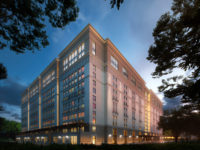2012 London Olympics: Architects Grapple With Publicity Clampdown
 |
| Photo courtesy London 2012 |
Firms that designed venues for the 2012 London Olympics, but didn’t pay “sponsorship” fees, weren’t allowed to promote their involvement. |
For Deborah Saunt, principal of the London-based DSDHA, designing a building for the 2012 Games—the tallest tower in the athletes’ village—was the kind of break most young architects can only dream of.
But it wasn’t clear how Saunt would parlay the commission into more business. Like all the architects involved in the Olympics, Saunt signed a contract ceding publication rights to the city’s Olympic Delivery Authority (ODA). That meant she couldn’t release renderings or photos of the building without its permission. And, she says, she could talk about the Olympics project only if someone asked about it. “We couldn’t go ahead and promote ourselves,” she says.
Saunt wasn’t alone among Olympics-connected architects hemmed in by what many have described as a gag order. Ken Shuttleworth, whose firm, Make Architects, designed the handball arena (known as the Copper Box), was refused permission to feature photos of it in his company’s annual report. And Roger Hawkins, whose firm, Hawkins\Brown, redesigned Stratford Regional Station, the main gateway to the Olympics, was unable to nominate the building for a Civic Trust Award, which would have meant sending out photos. Other firms said that with the World Cup in 2014 and the Olympics in 2016 (both in Brazil) coming up, they were hamstrung in their ability to market their services.
Peter Murray, a tireless promoter of British architects, said he was refused permission to mount an exhibition of Olympics architecture as part of the New London Architecture program, of which he is chairman. “It raises issues of free speech that I find really offensive,” he says of the publicity clampdown. According to Murray, architects risked possible criminal penalties if they defied the rules. In response, he is planning a Pecha Kucha–style event during the London Festival of Architecture (June 23–July 8) called “Honestly, Officer, I Never Designed an Olympics Building.”
What particularly angered some architects is that firms that paid money to sponsor the Games seemed to be largely exempt from the restrictions. Populous, the architects behind the main Olympics stadium and other Games-related projects, and Atkins, the architecture and engineering firm responsible for environmental and infrastructural planning, paid an undisclosed amount to become official sponsors of the Games.
“The reason we decided to become a sponsor was so that we could tell our story about our work on London 2012—to showcase the London 2012 Games as a feat of engineering excellence,” Jane Shiels, an Atkins spokeswoman, wrote in an e-mail. Atkins was allowed to produce brochures and videos touting its involvement in the Games, while nonsponsor firms had trouble distributing a simple press release.
But architects who have felt stymied are seeing the light at the end of the tunnel. The ODA has turned the site over to the London Organizing Committee—which has “loosened up a bit in the last few weeks,” says Sharon Nolan, a Make spokesman. Or, as Hawkins puts it, when it comes to publishing images of Olympics-related projects, “the door has opened a bit more.” (His firm’s website now makes prominent reference to the Stratford station.)
One thing all the firms agree on: After the opening ceremonies on July 27, photos of their work will be everywhere, and any “gag order” will be moot.


